Start with this three-week barbell bicep curl plan. If you’re looking to build muscle and strength in your arms, You won’t be disappointed!
Do you want to have strong arms? Guess what, Everyone does! But building strong arms doesn’t happen overnight and it certainly doesn’t require expensive gym memberships. In this article, we are going to provide you with a 3-week barbell bicep curl plan that can easily be incorporated into your routine.
What is a Barbell Bicep Curl?
Technically speaking, a single-joint isolate exercise is the barbell curl. that is typically done as an auxiliary movement during pull- or back-and-bicep workout sessions. Despite being used for decades, it is still recognized as a reliable workout that consistently ranks among the best bicep builders.
Even with its simplicity and how common the required equipment is, some lifters may find issues with performing the exercise due to physiological incompatibility or simply poor form adherence.
Benefits of the Barbell Bicep Curl
The barbell bicep curl, along with the bench press and barbell row, is perhaps one of the most popular gym exercises. You get to use a popular gym item (the barbell), lift more weight, and have enough range of motion to make your biceps burn. Despite its popularity, many people fail to fully utilize the action and develop a set of excellent biceps.
Bicep curls are as simple as they come at first appearance. You take hold of a weight and move your elbows in both directions. But upon closer inspection, performing a successful bicep curl requires skill. When performed properly, the barbell bicep curl increases the size of your arms and develops strength that may be used for other exercises and activities. For instance, having strong biceps improves back exercises and makes some daily tasks simpler. (3)
The Anatomy of the Biceps Muscle
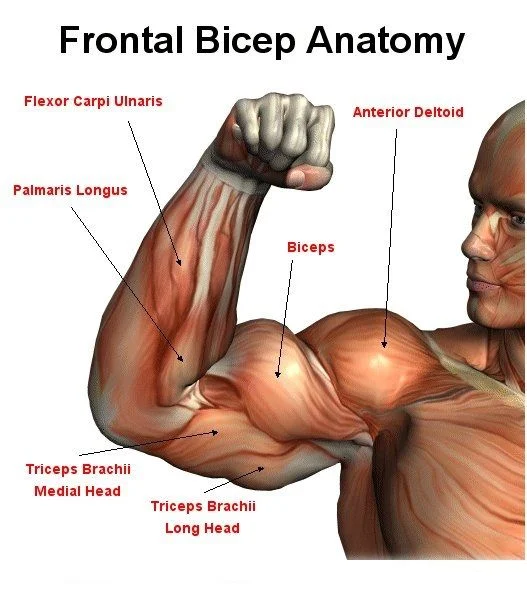
Before we dig into how to do different variations of the bicep curl, a quick anatomy lesson.
While we often refer to the muscle on the front of the upper arm as a “bicep,” it is properly referred to as a “biceps,” because it is made up of two (bi) muscle heads — the long head and the short head — that operate together as one muscle.
The long head originates from up by your shoulder in a cavity in your scapula called the glenoid. The short head originates at a projection in the scapula called the coracoid.
The long and short heads join together in the middle and connect to the bone via tendons just beneath the elbow joint on a place called the radial tuberosity.
Something to keep in mind about the biceps is that they are much longer than you realize. It runs through both the shoulder and elbow joints. To engage the entire biceps as much as possible, we want to do a curl that utilizes the muscle’s full range of motion. More on that later. However, keep that information in your working memory for the next 30 seconds. (4)
How to do Barbell Bicep Curl

Barbell Bicep Curl Instructions
- The standing barbell curl is a staple of many bicep-building workouts. Using an underhand grip (palms facing up), grasp a barbell or Olympic bar at about shoulder-width apart.
- Stand tall with your feet together (you may find it more comfortable to put one foot back for support), your back straight, and your arms fully extended.
- The bar should not come into contact with your body.
- Slowly curl the bar up while keeping your gaze forward, elbows tucked down at your sides, and body still.
- Squeeze your biceps hard at the top of the action, then gradually drop them back to the beginning position.
- Repeat for the appropriate number of reps.
Barbell Bicep Curl Tips:
- The most common mistake lifters make on this exercise is swinging the body back to help move the weight up. This is unethical! Only your biceps should be utilized to lift the weight, not your entire body.
- Another blunder is failing to keep the elbows fixed and tucked at the sides. When lifting the weight, avoid bringing your elbows forward.
- Finally, you must maintain weight management throughout the set. This means not dropping it too rapidly!
Common Mistakes of Barbell Bicep Curl
Bending the Wrists
The wrists should be retained firmly in a neutral posture throughout the exercise, decreasing pressure on the tiny connective tissues and better translating force produced by the biceps.
Whether by overpronating, over-supinating or rotating the wrists in some way, allowing the wrists to be pulled out of a neutral alignment can lead to discomfort and injury.
This is the most common error made during barbell curl performance, and it is the cause of many lifters’ wrist or forearm soreness when curling a straight barbell.
Elbows Floating or Upper Arms
Lifters should keep their upper arms immobile at the sides of their chest, with the elbows moving as little as possible while going through a full range of motion, to prevent engaging the deltoids or any other muscle groups other than the biceps themselves.
Not only can making either mistake lead to the biceps failing to be recruited, but it can also lead to injuries if excessive weight is used.
Using an Insufficient Range of Motion
Regardless of the activity, ensuring that the entire range of motion is used will guarantee that the muscles are trained as effectively as possible.
In the case of the barbell curl, this is all the more important, as failing to complete the full range of motion of the exercise can cause sticking points or instability of the biceps to increase over time.
A full range of motion should include the barbell being fully extended around the waist or pelvis, with the opposite end at shoulder elevation. Deviating from this range can have an effect on the mechanics or advantages of the barbell curl.
Swinging the Torso
Even if the upper arm or elbows are relatively immobile, motion can be produced by the lifter swinging their torso backward, depriving the biceps of stimulus and perhaps straining the lower back.
As a general rule, any sort of force produced by a muscle other than the biceps will negate the benefits of barbell curls. Just like the upper arms, it is best to keep the torso stationary and upright throughout each repetition.
Workouts and Training Programs That Include the Barbell Bicep Curl
Bicep Training Programs
- Armageddon. 3x/week. A four-week program that focuses completely on high-volume, high-intensity arm training, causing your biceps and triceps to grow in response.
- StrengthLog’s Upper/Lower Body Split Program. 4x/week. A hypertrophy program, divided into two upper body and two lower body workouts a week.
- StrengthLog’s 4-Day Bodybuilding Split. 4x/week. A traditional 4-day bodybuilding split.
Barbell Bicep Curl Variations
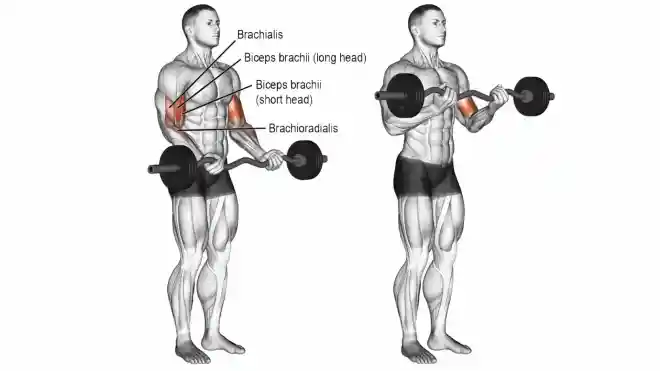
EZ-Bar Curl
If changing hand location does not relieve forearm or wrist pain, switching to an alternative barbell curl that uses an EZ barbell should help minimize – or eliminate – feelings of discomfort.
The EZ-bar curl is mechanically and physiologically identical to the barbell curl, only with a bend in the handles to aid in proper wrist and hand positioning. (1)
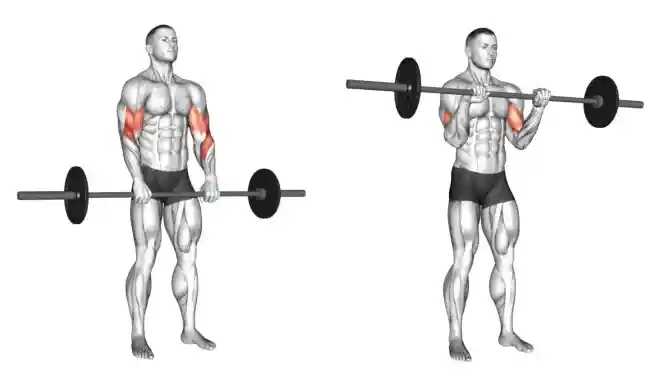
Reverse Barbell Curl
Lifters wanting increased brachialis and forearm muscle recruitment in addition to biceps recruitment will benefit from executing a reverse barbell curl with hands in a pronated posture rather than a supinated position.
The reverse barbell curl is much the same as a regular barbell curl, only with the bars gripped differently and muscles like the brachialis and forearm flexors utilized as primary mover muscles.
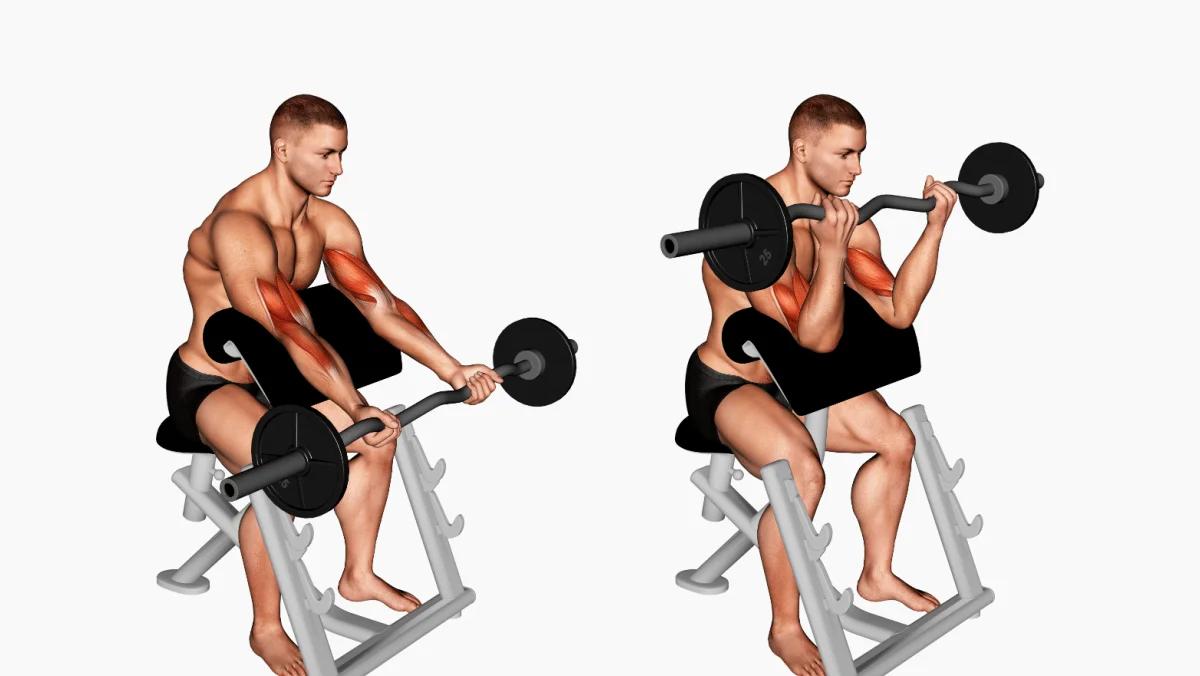
EZ Barbell Close Grip Preacher Curl
The EZ bar tight grip preacher curl is a preacher curl variation that employs an EZ bar with a close grip. The curved design of the EZ bar provides for a more natural hold and movement, whereas the close grip isolates the biceps and emphasizes the brachialis muscle. (2)

Barbell Close Grip Concentration Curl
The close grip barbell concentration curl exercise is harder than the normal dumbbell concentration curl and may not be good for beginners.
It is an excellent arm action for engaging the brachialis and biceps muscles.
Barbell Bicep Curl Alternatives
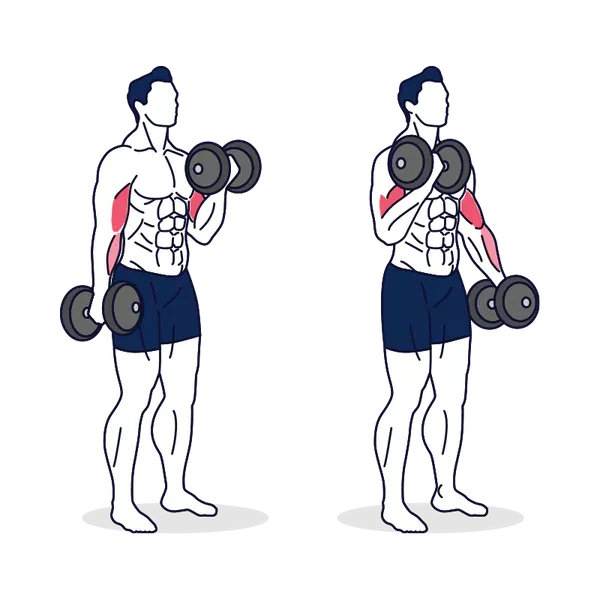
Dumbbell Bicep Curls
Dumbbell bicep curls are a popular exercise for building biceps. They are relatively easy to do and can be performed with just a pair of dumbbells.
Stand with your feet shoulder-width apart and your knees slightly bent to perform a dumbbell bicep curl. With your hands facing up and your arms at your sides, hold a dumbbell in each hand. Curl the dumbbells slowly up to your shoulders, keeping your elbows tight to your sides. Pause at the top of the movement before gradually lowering the dumbbells back to the starting position.

Hammer Curls (dumbbell)
Another terrific movement for bicep growth is the hammer curl. Unlike traditional curls, the idea here is to keep a neutral hold (palms facing each other). By doing so, you effectively engage your brachioradialis muscle. Hammer curls are particularly helpful for stressing the biceps because trainees can often lift a bit more weight.
Summary
Remember to always perform the barbell bicep curl with the best technique you can muster, and to avoid using too much weight until you are more comfortable with resistance training in general.
FAQs
Is barbell curl good for the biceps?
which barbell curl is best for the biceps?
what is the correct form of a bicep curl?
How Many Times (Reps/Sets) Should I Do Barbell Curls?
This allows for both hypertrophy and strength improvements to occur without overfatiguing the body, which is ideal for an accessory isolation exercise like the barbell curl.
References
1. Coratella, G., Tornatore, G., Longo, S., Esposito, F., & Cè, E. (2023). Bilateral Biceps Curl Shows Distinct Biceps Brachii and Anterior Deltoid Excitation Comparing Straight vs. EZ Barbell Coupled with Arms Flexion/No-Flexion. Journal of Functional Morphology and Kinesiology, 8(1), 13.
2. Nunes, J. P., Jacinto, J. L., Ribeiro, A. S., Mayhew, J. L., Nakamura, M., Capel, D. M., … & Aguiar, A. F. (2020). Placing greater torque at shorter or longer muscle lengths? Effects of cable vs. barbell preacher curl training on muscular strength and hypertrophy in young adults. International journal of environmental research and public health, 17(16), 5859.
3. García-López, D., Herrero, A. J., González-Calvo, G., Rhea, M. R., & Marín, P. J. (2010). Influence of “in series” elastic resistance on muscular performance during a biceps-curl set on the cable machine. The Journal of Strength & Conditioning Research, 24(9), 2449-2455.
4. Athwal, G. S., Steinmann, S. P., & Rispoli, D. M. (2007). The distal biceps tendon: footprint and relevant clinical anatomy. The Journal of Hand Surgery, 32(8), 1225-1229.





